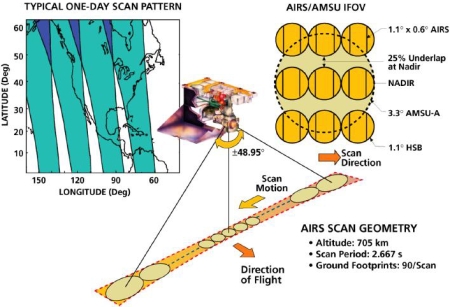This project focuses on the development of lossless algorithms for compression of the signals from environmental satellites. Specifically, our group is designing, analyzing, and implementing a compression suite for the next-generation GOES-R instrument to be launched in 2012.
The Problem
Environmental satellites must process up to 20 million samples in one second while operating at less than 1 watt per million samples per second, and environmental scientists are interested in every bit of that data. More importantly, this data must be transmitted over a noisy medium with limited bandwidth.

Atmospheric Infrared Sounder (AIRS)
Our group will be using current spacecraft to simulate data from the upcoming GOES-R instrument. We will be focusing on Aqua Spacecraft's AIRS instrument in our case study. The AIRS is a high resolution instrument which measures infrared radiances at 2378 frequencies ranging from 3.74-15.4 µm. The AIRS takes 90 measurements as it scans 49.5° perpendicular to the satellite's orbit every 2.667 seconds (cross-track). The data is distributed in granules -- 6 minutes of data (or 135 of these scans). So our input is a 90x135x2378 cube of data;
The Solution
Haar/Cosine Transform
We used non-separable, multi-dimensional transforms for data reduction along the natural dimensionality of the sounder data. This immediately improved the compression ratio.

Empirical Mode Decomposition
We used a variant of the empirical mode decomposition with an adaptive clustering algorithm in order to smooth the data.

